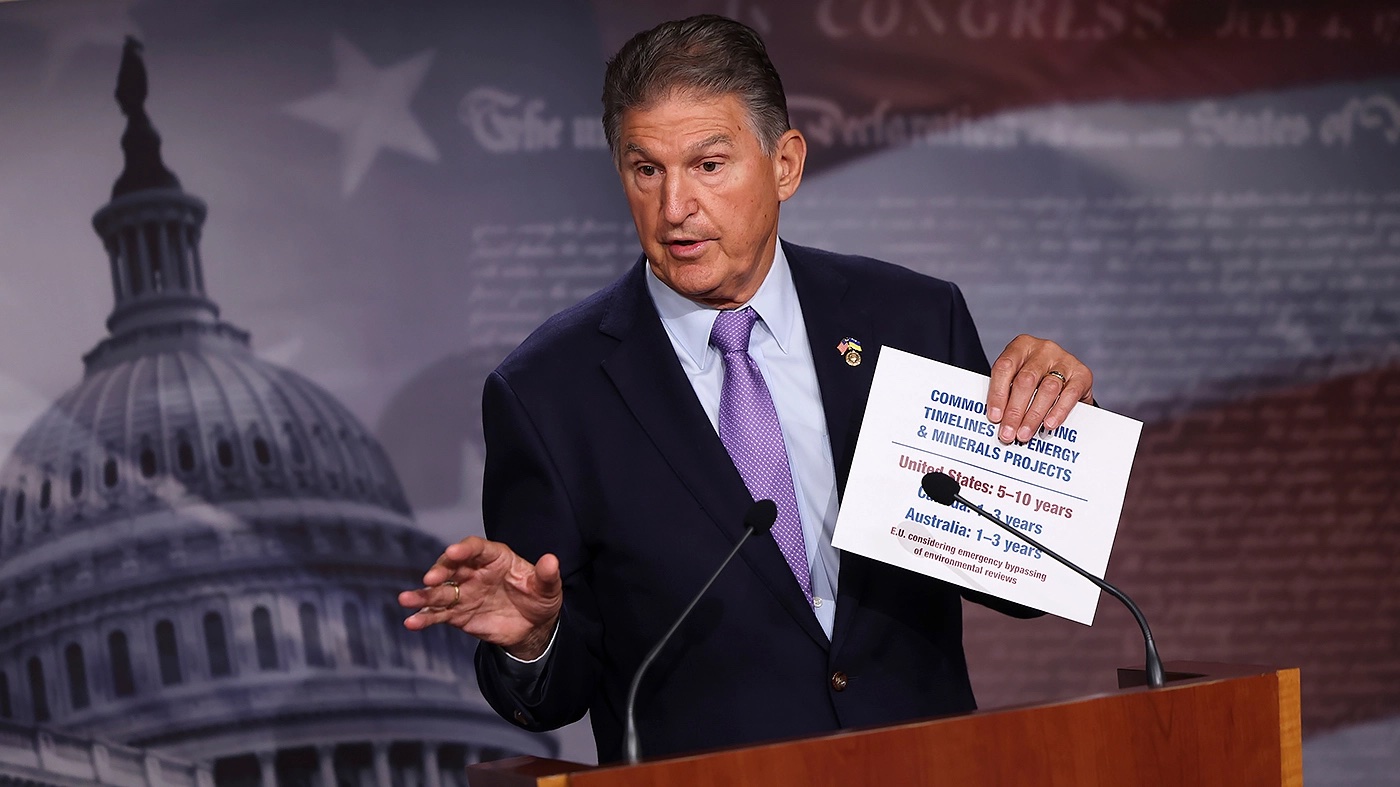At $369 billion, the recent Inflation Reduction Act (IRA) is the single biggest investment to fight climate change in American history. Official estimates put the United States on track to cut greenhouse gas emissions in half by 2030 and reach net zero emissions by 2050, a huge victory for environmental advocates. The bill increases funding for climate technology research and expands clean energy tax credits, incentivizing the decarbonization of the US energy grid and eliminating one of the final economic hurdles for the long-awaited transition to carbon-free energy production. However, these projected gains are contingent on one more major obstacle being cleared: permitting reform.
Permitting refers to the process of securing permits for the construction and operation of large-scale energy projects, which currently involves protracted and expensive environmental review and community input stages. Proponents of reform, like Senator Joe Manchin (D-WV), seek to streamline the permitting process by reducing avenues for slowdowns and added costs. Simplifying front-end regulatory processes, they argue, will incentivize the energy investments necessary for a green future.
The case for permitting reform is simple. Experts agree that our transition away from fossil fuels will require massive upgrades in the nation’s energy infrastructure. In addition to solar fields, wind farms, and geothermal plants, the United States needs better transmission lines, more substations, and thousands of new transformers to supply and transport this energy. But completing all of these projects will involve years’ worth of permitting struggles, a burden that, as things stand right now, discourages key development of this kind.
The current American permitting bureaucracy is unacceptably complex and comes at the expense of bold new energy development. The bulk of the permitting process is dictated by the National Environmental Policy Act (NEPA), a 1970 law that sets standards for environmental review on all new development in the United States. For small projects, these environmental reviews can take months and thousands of dollars to complete. And the kind of major development envisioned by the IRA would likely take four and a half years across all federal agencies and cost millions of dollars. One notoriously slow agency, the Federal Highway Administration, has an average review time of 8.6 years. All of this must take place before a single shovel hits the ground.
In addition to environmental review, another part of the permitting regime in desperate need of reform is the regional input process, which lends itself to abuse by local communities reflexively opposed to development. Under current rules, nearby landowners have exhaustive powers to demand additional costly review and even pursue legal challenges to new projects, further complicating an already cumbersome process. Considering the resulting costs—in both time and money—associated with these projects, clean energy developers and investors are actively discouraged from building the exact infrastructure that the nation’s energy transition hinges on. In terms of technology, incentives, and public opinion, the United States is ready for its energy transition, but outdated government policy is standing in the way.
The problem, of course, is not that communities have a say in nearby development or that the potential environmental impact of major projects is examined so closely. These are positive aspects of the process that often go hand-in-hand with sustainable development. The problem is that these well-intentioned tools for review, input, and litigation have largely been weaponized by small groups of wealthy landowners, not representative of their communities, who use every tactic at their disposal to slow down projects and discourage development. Pair this with the convoluted and outdated structure of these laws and the cash-strapped agencies tasked with executing them, and it’s no wonder that energy projects have so much trouble getting off the ground.
Most proposals to reform the permitting process involve, in one way or another, gutting NEPA. This has raised obvious concerns around dismantling legislation that has won environmentalists high-profile victories in the past. But NEPA as a vehicle for environmental protection is simply not compatible with the robust investments needed in US energy infrastructure today. Despite its noble aim, NEPA is a deeply flawed piece of legislation that currently perpetuates a staggeringly inefficient and inequitable permitting system. There’s a reason, after all, that comparable countries to the United States with equally stringent environmental laws manage to maintain firm review deadlines. The United States does not need to sacrifice its commitment to environmental safety in order to encourage construction. Targeted reform can expedite the permitting process without compromising quality.
So what does targeted reform mean? One important step will be imposing strict timelines on the review process, building on recent legislation like the FAST-41 statute to include standard timeframes for request processing, review, and approval. In order to keep up with these expedited timelines, any proposal will have to be accompanied by increased funding for the agencies in charge of permitting, which will also help to reduce the existing backlog of federal permit requests. To this end, existing categorical exclusions for compliant projects should also be expanded, freeing up agency resources to speed up permitting. Unwarranted litigation over new projects can be reduced by shortening the statute of limitations on energy projects from the current six years established by the Administrative Procedure Act. Finally, the process should be centralized by assigning clear jurisdiction for most review to just one agency, eliminating the costly interagency back-and-forth that is rampant today.
To realize our dreams of decarbonization, we must build clean energy infrastructure at a massive scale. This simply cannot happen without permitting reform. The IRA provides the framework and incentives for the decarbonization of our energy grid, but its success is contingent on a permitting process that doesn’t waste time and money and discourage investment. We cannot let byzantine environmental review laws stand in the way of such important development. It’s time to enact federal policy that facilitates the execution of these ambitious projects. In order for a stable and secure clean energy transition, permitting reform must get done.
